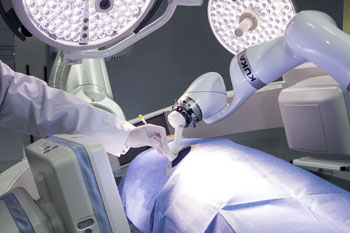Robotic Assistant Helps Position Interventional Needles
By HospiMedica International staff writers
Posted on 11 Nov 2016
An innovative robotic arm can help clinicians precisely position interventional needles at the optimal insertion point.Posted on 11 Nov 2016
The robotic arm, developed jointly by researchers at the Fraunhofer Institute for Manufacturing Engineering (IPA; Stuttgart, Germany) and the Fraunhofer Institute for Medical Image Computing (MEVIS; Bremen, Germany) traces the initial interrogatory computerized tomography (CT) scan, using a calibration tool to determine the ideal position to target a specific point in the image. Software developed at MEVIS then analyzes the image and supports the doctor in placing the virtual needle, displaying it in the image.

Image: A robotic assistant helps position interventional needles (Photo courtesy of Fraunhofer IPA).
If, instead of a biopsy, the aim of the treatment is direct heating, cooling, or high-energy beams into a tumor, the software also simulates energy propagation throughout the tissue. The last step is to determine the number of needles required and their relative positions so as to destroy the entire tumor. Once a treatment plan is complete, the robotic arms calibration tool is replaced with a needle guide. The robot then transports the guide to the calculated position and angle on the skin; the doctor then inserts the needle into the tissue through the guide, held in place by the robot.
The robotic assistance requires just five minutes to accurately position the needle, as opposed to 30 minutes with conventional techniques. In addition, the robotic arm reduces radiation exposure for both the doctor and patient; in conventional needle insertion, the needle is held in place manually, obscuring part of the X-ray and exposing doctors’ hands to radiation. With the robotic arm, which is impervious to radiation, the needle is held in place with its needle guide. There is also a significant reduction in the patient’s radiation exposure. As a result, the number of monitoring X-rays is greatly reduced.
“Whereas humans struggle to position this sort of needle, it’s hard to beat a robot designed for the purpose. Our system removes burdens for doctors while leaving them in control,” said Andreas Rothfuss, of the IPA Project group for Automation in Medicine and Biotechnology (PAMB). “A human needs 30 minutes to position the needle, but with robot assistance this is cut down to five minutes at most.”
Related Links:
Fraunhofer Institute for Manufacturing Engineering
Fraunhofer Institute for Medical Image Computing














